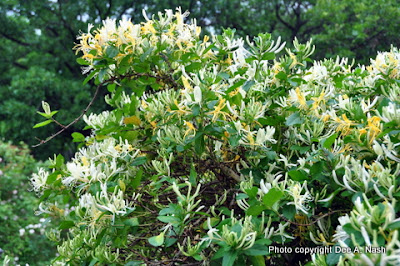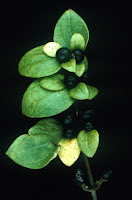Sharon Plumb was kind enough to take time out
of her busy day to talk to me about the invasive species of Vermont and the
work that she and the rest of the folks at TNC are doing about them. There
seemed to be three pillars to the work she does as the Invasive Species Coordinator with the Vermont Chapter of The Nature
Conservancy; policy, outreach and education, and eradication. During our
conversation she focused on the outreach side of things.
When she initially began working for TNC
their outreach was directed towards gardeners and the general public. However
more recently Forester outreach has also been thrown into the mix. Within the realm of forestry professionals
there are three types of foresters who offer services to woodland owners:
procurement foresters, public service foresters, and consulting foresters. All of these types of professionals, if
educated on invasive species, can help to further the movement by providing
information to the landowners that they work with.
Ms. Plumb mentioned the recently created Best
Management Practices that by law are required to be used and incorporated into
any forest management plan that is enrolled under the Current Use Program.
Foresters therefore must be aware of these BMPs and of invasive species
themselves.
IMapInvasives is another tool that Ms. Plumb
brought up during our chat. This database is used for prevention and management
that has been useful as far as tracking and mapping the spread of invasives
goes. This program has only been around in Vermont for 8 or 9 months but it is
already making waves. The free, web based database is available to anyone with
internet access and is simply and easy to learn. A 45 minute training program
is offered on IMapInvasives that will make you truly an expert and the trainings
are always well attended by land managers and the members of the general public
alike. Another good thing about the
database is that New York and New Hampshire are using the same program. This
allows for some cross border work to take place and hopefully this
collaboration will help to strengthen our defense against these pests.
In addition to workshops being held on
IMapInvasives, The Conservancy and a myriad of other organization host dozens
of different workshops every year. Their next training is to take place on May
29th.
When asked what her greatest concern
regarding the invasives in the northeast Ms. Plumb responded that she was most
concerned for the future health of our forests. Invasive terrestrial plants
have taken over many areas of Vermont so that no native plants or trees are
growing in the understory whatsoever. In other places native vegetation and
regrowth can be seen in the understory; however the growth rates are often set
back more than ten years.
We thought that it was important to learn
from Sharon Plumb what we could do to help the effort. She expressed that in
her mind there is not enough political attention of resource allocation to these
issues. Plumb suggested that students such as ourselves should urge our senators
and other representations to appropriate money to help hire additional staff
people to do this type of work, there just isn’t enough. A letter writing
campaign was discussed as a means for getting this point across to the policy
makers. Additionally we can take part in educating others or take part in
removal projects.
Sharon suggested that those interested in
learning more could visit their newly launched website which so far has been a huge
success in reaching more people and creating a much needed buzz around the
issue of invasive species.
Sabrina Smits






